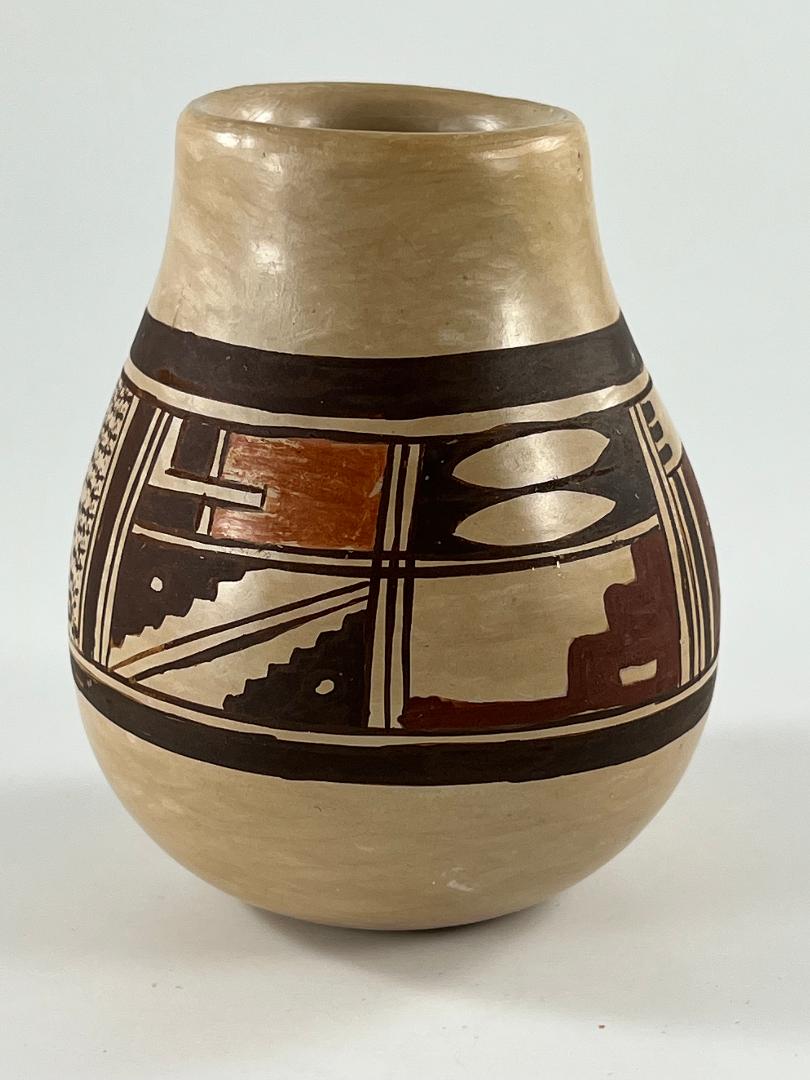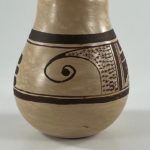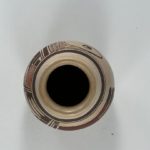This is a small, unexceptional Hopi-Tewa pot. It is include in this collection because it is the first pot I have owned by Finkle Sahmie (1947-2017), the second child of Priscilla Namingha, and thus brother to Jean, Randall, Andrew, Nyla, Rachael and Bonnie. All the girls became well-known potters, but of the boys, only Randy fully engaged in the art. Jar 2021-01 is a perfectly fine pot, but is not “exceptional” as one might expect from his sisters or Randy.
Form:
From a 1-inch base, the pot rises outward 1.5-inches to a waist, then slopes inward 1.625-inches to 0.75-inch neck. The transition between these zones is unusually gentle so that held in the hand the flat base and the short neck feel distinctive, but the surface between feels like one smooth curve. The walls of the jar are quite thick; consequently the pot feels a bit heavier than expected.
Design:
The circumference at the waist is 9-inches and is marked by a thin-over-thick framing lines. Above is a 1.25-inch tall panel of designs, topped by thick-over-thin framing lines. The design panel contains two sections, but unusually one panel occupies about 61% of the circumference of the pot while the other fills the remaining 39%.
Against the right wall of the large section is a stippled element painted in brown (or watered-down black) paint. Half-an-inch wide at the base, it curves outward to a 1.25-inch pointed width at the top. From the point extends a black 2.25-inch-long proboscis curved counter-clockwise and ending in a substantial black ball. The form is much like the avian head often found on Hopi pottery, except that this rendition lacks an eye and a topknot.
Nampeyo often used a set of parallel black lines to separate the segments of her design, a format I call a “highway.” Finkel uses three such lines (a “two-lane highway”) on the left edge of this segment. Unusually he has added another three-lane highway to the right of the first, this one having a wide, black central lane, sort of a two-lane highway with an esplanade. This second highway extends about 80% of the distance from the bottom of the design, leaving a 0.25-inch gap at the top. Attached to the wall in the open space, and intruding 0.125-inches, are a set of three parallel black lines. Below, and based on the highway with an esplanade, is a large, red, rectangular base that on its right edge separates into three rectangular feathers. Each feather displays a black tip with a curved end. This element, which I call a “red base comb, black tipped,” was also used by Nampeyo. (See “Appendix F” under “Tails.”) About an inch of space separates the two designs in this large design segment.
The second design segment, to the left of the first, is rectangular is shape and is divided into quadrants by a verticle two-lane highway and an horizontal one-lane highway. The upper-right quadrant contains two unpainted lens-shaped elements against a black background. The quadrant below contains a three-stepped stylized cloud image or kiva steps, with the bottom step extended to the width of this segment. Embedded in the cloud element is an unpainted rectangle, like a window. The top left quadrant of this segment contains a variation of the “red base comb, black tipped” feathers we saw in the first design segment. Two feathers are shown, the top shorter than the bottom. A small unpainted strip separated the red base from the black tips, which have square ends. The bottom left segment has a somewhat more complex layout. The upper-left and bottom-right corners contain black triangles with saw-tooth edges, similar to the kiva steps in the segment to their right. At the center of each triangle is an unpainted circle. The residual unpainted diagonal between these triangles has saw-tooth edges. In the center of the diagonal are two parallel lines, a one-lane highway. The left edge of this segment is a four-lane highway, with the third lane a thick black line, like an off-center esplanade.
Design Analysis:
The elements of design are common on Nampeyo family pottery and the painting, while competent, is not exceptional. That the design segments are of unequal length is unusual and eye-catching, as is the central empty space in the first design segment. Finkle clearly has a talent for forming and painting pottery, but as near as I can tell he made pots for only a short amount of time and did not develop this talent.






